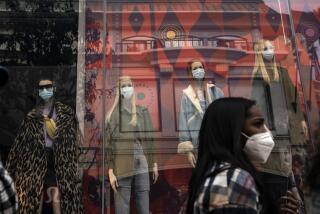SARS Virus May Be Robust
- Share via
The virus that causes SARS can survive in the environment much longer than researchers had suspected, the World Health Organization said Sunday, suggesting that halting transmission of the disease may be harder than they thought.
Research from laboratories around the world, posted on the WHO’s Web site, indicates that the SARS coronavirus can persist on public surfaces for a day or longer and in feces from infected people for as long as four days -- much longer than the coronaviruses that cause the common cold. It can survive even longer at low temperatures. And one commonly used detergent does not kill the virus as readily as researchers had hoped.
“This is the first time we have had hard data on the survival of the virus,” said Dr. Klaus Stohr of the WHO, which is based in Geneva. “Before, we were just speculating.”
Stohr cautioned that the full meaning of the findings will not become clear until researchers learn how much virus is necessary to trigger an infection. That the virus can persist for hours on, say, handrails in a bus station may not be important if there is not enough of the virus present to produce disease.
As of Sunday, severe acute respiratory syndrome had sickened more than 6,300 people worldwide and killed at least 449. There were 13 new deaths in Asia, including seven in mainland China, five in Hong Kong and one in Singapore. The United States has 54 probable SARS cases and no deaths.
China reported 163 new SARS cases, the lowest daily total in two weeks. Many of the new cases occurred in the poorer inland provinces, including 35 in Inner Mongolia, but 69 of them were in Beijing.
Over the weekend, the Chinese government tripled the amount of money targeted for the disease to $725 million.
The eight new SARS cases in Hong Kong provided further evidence that the outbreak there is tapering off, but authorities were concerned about the situation in Taiwan, where the spread of the disease seems to be accelerating. The number of probable SARS cases in Taiwan has tripled to 116 in the last 10 days, and there have been eight deaths, including five that were announced Friday.
In an unusual concession, the Chinese government has allowed the WHO to send two physicians to Taiwan to help island officials deal with the outbreak. The team, with expertise in epidemiology and virology, arrived Saturday. One of the doctors’ initial goals will be to halt the spread among health-care workers treating SARS patients.
Also over the weekend, the international soccer federation, FIFA, said the Women’s World Cup scheduled for China this year will be moved to another country because of the SARS outbreak. The United States and Australia are bidding to hold the tournament, scheduled for Sept. 23 to Oct. 11, and Brazil and Sweden may also put in bids.
Scientists remain convinced that the main way the disease is spread is through the coughs of patients. The greatest danger is thus to people in their immediate vicinity. But the new findings about the virus’ ability to survive in the environment were not entirely unexpected.
Researchers have long known that the coronaviruses that cause colds can be transferred on surfaces -- particularly when people do not wash their hands frequently -- and there was no reason to think the new coronavirus would behave differently.
Authorities in Hong Kong, however, believe the March outbreak in the territory’s 33-story Amoy Gardens apartment complex was caused by leaking sewage that transferred the virus from one infected individual to hundreds of others.
To test that possibility, researchers at the Hong Kong Department of Health spiked stool samples with the coronavirus and monitored how long it survived. In feces from a baby, the virus lived for three hours, while in normal feces from an adult, it persisted for six hours. But in feces from a person with diarrhea, the virus lasted at least four days.
Overall, the SARS coronavirus has caused diarrhea in about 10% of the people it infects. But in the Amoy Gardens outbreak, about 60% of the victims suffered diarrhea, which may help to explain the rapid spread through the building.
Health authorities found that a sewer line in the building had a fracture that might have allowed liquid containing the virus to become aerosolized so that residents could breathe it in. Alternatively, the leaking sewage might have been spread by cockroaches.
Stohr said the new finding could be particularly important because “traces of stool could occur on surfaces in hospitals,” providing a previously unexpected pathway of transmission.
In a separate study, researchers at the National Institute of Infectious Diseases in Tokyo measured the virus’ response to various temperatures. They concluded that, outside the body, the virus died relatively quickly at body temperature but survived for fairly long periods as temperatures dropped below 40 degrees. It persisted indefinitely at temperatures around freezing, a trait shared by most viruses.
Those findings suggest that if a person whose hands were contaminated by the virus handled glassware in a refrigerator, the virus could persist on those surfaces indefinitely.
Finally, researchers in Hong Kong and at the University of Marburg in Germany placed the virus on a plastic surface at room temperature and found that it could live for at least 24 hours.
“It survived easily,” Stohr said.






